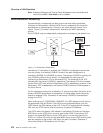
This information applies to addresses entered for ATM; LAN emulation;
Classical IP and ARP over ATM; and IPX and ARP over ATM.
ATM-LLC Multiplexing
Protocols that run natively over an ATM interface can use ATM-LLC multiplexing to
share ATM addresses and both SVC and PVC channels between users. ATM-LLC
is implicitly configured when the protocols are configured and can be monitored
using the ATM Config+ command prompt from t5. There are no explicit
configuration options for the ATM-LLC multiplexing function. For example, if two
protocols which use ATM-LLC multiplexing are configured to use the same local
ATM address (local endpoint), this implicitly configures ATM-LLC to use the same
shared ATM address for both protocols.
See “ATM-LLC Monitoring Commands” on page 290 for additional information.
Sharing of ATM addresses or SVC/PVC channels is not possible between protocols
that use the ATM-LLC multiplexing function and those that do not use the ATM-LLC
multiplexing function (such as Classical IP). Currently, Server Cache
Synchronization Protocol (SCSP) and APPN are the only two protocols that use the
ATM-LLC multiplexing function.
ATM Virtual Interface Concepts
An ATM Virtual Interface (AVI) creates the appearance of multiple ATM interfaces
when, in fact, there is only one physical ATM interface. One or more AVIs can be
configured for each physical ATM interface on the router. AVIs have the following
characteristics:
v Each AVI must be defined on one (and only one) physical ATM interface. ATM
real interface (ARI) will be used to mean a physical ATM interface.
v One or more AVIs can be configured on each ARI on a router.
v Higher layer protocols treat ARIs and AVIs equally. The protocols see the total
number of ATM interfaces as the sum of the number of ARIs and AVIs configured
on the router.
v Protocols can be configured on each ATM interface (real or virtual) independently
of other interfaces.
For example, one can configure IP on interface 0 (which is a real ATM interface)
with IP address 9.1.1.1 and another instance of IP with address 9.2.1.1 on
interface 1 (which is an AVI). Whether an interface is a real ATM interface or a
virtual interface configured on a real interface makes no difference to the protocol
(IP in the example). In addition, whether virtual interface 1 is configured on top of
real ATM interface 0 or some other physical ATM interface is also transparent to
the protocols.
Advantages of Using ATM Virtual Interfaces
Major advantages of using the ATM Virtual Interfaces are:
v Using the ATM Virtual Interface feature increases the number of protocol
instances that can be supported on a physical ATM interface.
The actual number of AVIs that can be configured on an ARI is limited by
physical resources, such as memory, available on the router. The total number of
Configuring ATM and LAN Emulation
274
MRS V3.2 Software User’s Guide


















